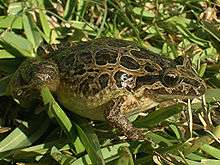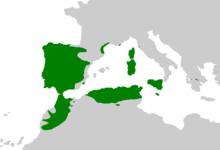Discoglossus
Discoglossus (common name: painted frogs) is a genus of frogs in the family Discoglossidae found in southern Europe and northwestern Africa.[1]
| Discoglossus | |
|---|---|
 | |
| Discoglossus galganoi | |
| Scientific classification | |
| Kingdom: | Animalia |
| Phylum: | Chordata |
| Class: | Amphibia |
| Order: | Anura |
| Family: | Alytidae |
| Genus: | Discoglossus Otth, 1837 |
| Type species | |
| Discoglossus pictus Otth, 1837 | |
| Species | |
|
6 or 7, see text | |
 | |
| Distribution of Discoglossus (in green) | |
Species
There are six species in this genus.[1] The Hula painted frog (Latonia nigriventer) was included in this genus until further genetic analysis placed the hula painted frog in the genus Latonia.[2]
| Binomial name and author | Common name |
|---|---|
| Discoglossus galganoi Capula, Nascetti, Lanza, Bullini & Crespo, 1985 | Iberian painted frog |
| Discoglossus jeanneae Busack, 1986 | Spanish painted frog |
| Discoglossus montalentii Lanza, Nascetti, Capula, and Bullini, 1984 | Corsican painted frog |
| Discoglossus pictus Otth, 1837 | Mediterranean painted frog |
| Discoglossus sardus Tschudi In Otth, 1837 | Tyrrhenian painted frog |
| Discoglossus scovazzi Camerano, 1878 | Moroccan painted frog |
gollark: To clarify, I'm saying you can't really usefully predict someone's behaviour by saying "well, they went serotonin and dopamine", since those are too low-level.
gollark: I'm responding to TF3, not you.
gollark: That's not exactly true (humans are not anything like rational [WHATEVER NEUROCHEMICAL] maximizers), and even if they *were* it wouldn't be very helpful since the processes involved are intractably complex.
gollark: Sometimes I move from my chair to retrieve food and such.
gollark: It feels awesome to have wanted to vomit? How?
References
- Frost, Darrel R. (2014). "Discoglossus Otth, 1837". Amphibian Species of the World: an Online Reference. Version 6.0. American Museum of Natural History. Retrieved 12 April 2014.
- "Discoglossus Otth, 1837". Integrated Taxonomic Information System.
- C. Michael Hogan. 2012. Discoglossus. African Amphibians Lifedesk. ed. Breda Zimkus.
- A. Salvador. 1996. Amphibians of Northwest Africa. Smithsonian Herpetological Information Service. 109, 1-43.
This article is issued from Wikipedia. The text is licensed under Creative Commons - Attribution - Sharealike. Additional terms may apply for the media files.